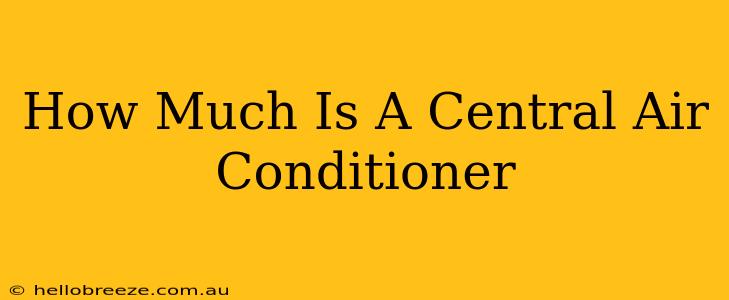Thinking about installing central air conditioning? The cost is a major factor, and it's not a one-size-fits-all answer. This guide will break down the price of a central air conditioner, exploring the various factors that influence the final cost. Understanding these factors will empower you to make informed decisions and get the best value for your investment.
Factors Affecting the Cost of a Central Air Conditioner
Several key factors significantly impact the overall cost of installing a central air conditioning system. These include:
1. Size and Type of System:
- Tonnage: The cooling capacity of an AC unit is measured in tons. A larger home or one with poor insulation will require a higher tonnage unit, resulting in a higher cost. Smaller units are generally less expensive.
- System Type: Different types of systems exist, including split systems (the most common), ductless mini-splits (ideal for additions or smaller spaces), and geothermal systems (highly efficient but expensive). The type of system you choose will heavily influence the total cost.
- SEER Rating: The Seasonal Energy Efficiency Ratio (SEER) indicates how efficiently the unit uses energy. Higher SEER ratings mean lower energy bills over time, but typically come with a higher upfront cost.
2. Installation Costs:
- Labor: Installation labor is a considerable expense. Factors like the complexity of the installation (existing ductwork, accessibility, etc.) will impact labor costs.
- Ductwork: If you need new ductwork or significant modifications to your existing system, expect a substantial increase in the overall cost. This is often the most expensive part of the installation, especially in older homes.
- Permits and Inspections: Local building codes require permits and inspections, adding to the total expense.
3. Additional Features and Upgrades:
- Smart Thermostats: These offer programmable features and remote control, enhancing convenience and potentially saving energy. However, they add to the upfront cost.
- Air Purifiers: Adding air purification features improves indoor air quality but increases the system's price.
- Variable-Speed Blower Motors: These provide more precise temperature control and can contribute to energy savings, albeit at a higher initial cost.
Estimating the Cost: A Breakdown
While precise pricing requires a professional consultation, you can get a general idea:
- Basic System (smaller home, standard SEER rating, minimal installation): Could start around $5,000 - $8,000.
- Mid-Range System (average-sized home, moderate SEER rating, some ductwork adjustments): Typically falls within the $8,000 - $15,000 range.
- High-End System (larger home, high SEER rating, extensive ductwork, additional features): Can easily exceed $15,000.
Remember: These are rough estimates. The actual cost can vary significantly based on your specific needs and location.
Finding the Right Central Air Conditioner for Your Needs
Choosing the right system requires careful planning. Here's what to do:
- Get Multiple Quotes: Contact several reputable HVAC contractors for estimates. Compare their pricing, proposed systems, and warranties.
- Consider Energy Efficiency: Investing in a higher SEER rated unit will pay off in lower energy bills over the system’s lifespan. Consider the long-term savings when comparing costs.
- Check for Warranties: Make sure the system and installation come with comprehensive warranties.
- Read Reviews: Look for online reviews of HVAC contractors in your area to gauge their reputation and quality of work.
Installing central air conditioning is a significant investment, but a properly sized and installed system will provide years of comfortable living and increased home value. By understanding the factors affecting cost and carefully researching your options, you can find the perfect system at the right price.

